February 28, 2016
The idea of a nomadic lifestyle has great appeal to me, which is especially surprising considering what a homebody I am. On the infrequent occasions I take trips requiring more than a day, they are fully planned and orchestrated with all the precision an anal-retentive like me can muster. Still, the idea of packing a minimum of gear into a beat-up car and taking off on a whim across the country has long been a fantasy, albeit one I’m sure I’ll never attempt to fulfill.
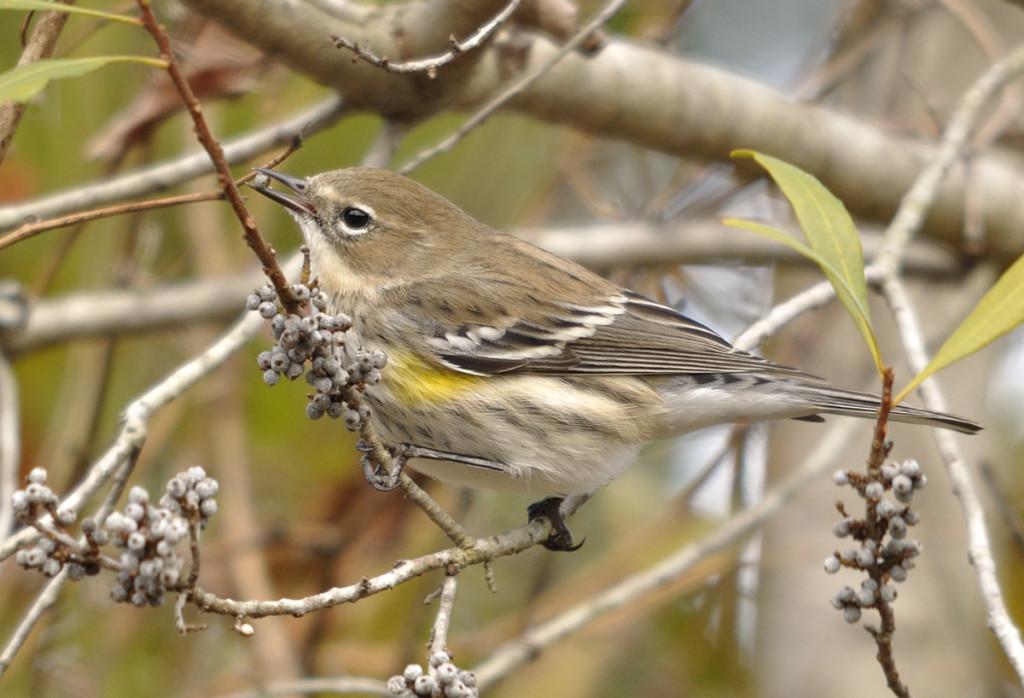
Yellow-rumped warblers are able to winter further north than most warblers, in part due to their ability to feed on the fruits of waxmyrtle and digest the waxy coating as well as the pulp.
Among North American birds, perhaps the ultimate nomadic species is the cedar waxwing. So many aspects of the lifestyle and habits of these thoroughly charming birds are unique, and most are directly or indirectly related to the fact that it is one of the relatively few bird species on the continent that can truly be called a frugivore. Sure, lots of wannabes will take fruit opportunistically at times, sometimes relying heavily on it for their caloric needs for short to moderate lengths of time. The ability of tree swallows and yellow-rumped warblers to winter in great numbers farther north than other members of their clans, which mostly depend on insects for the greatest portion of their provender, has been attributed in part to their ability to subsist largely on the fruits of winter-fruiting shrubs such as bayberry. Both species have the unusual ability to digest the waxy coating of bayberry and waxmyrtle fruits, allowing them to survive periods when insects are hard to find.
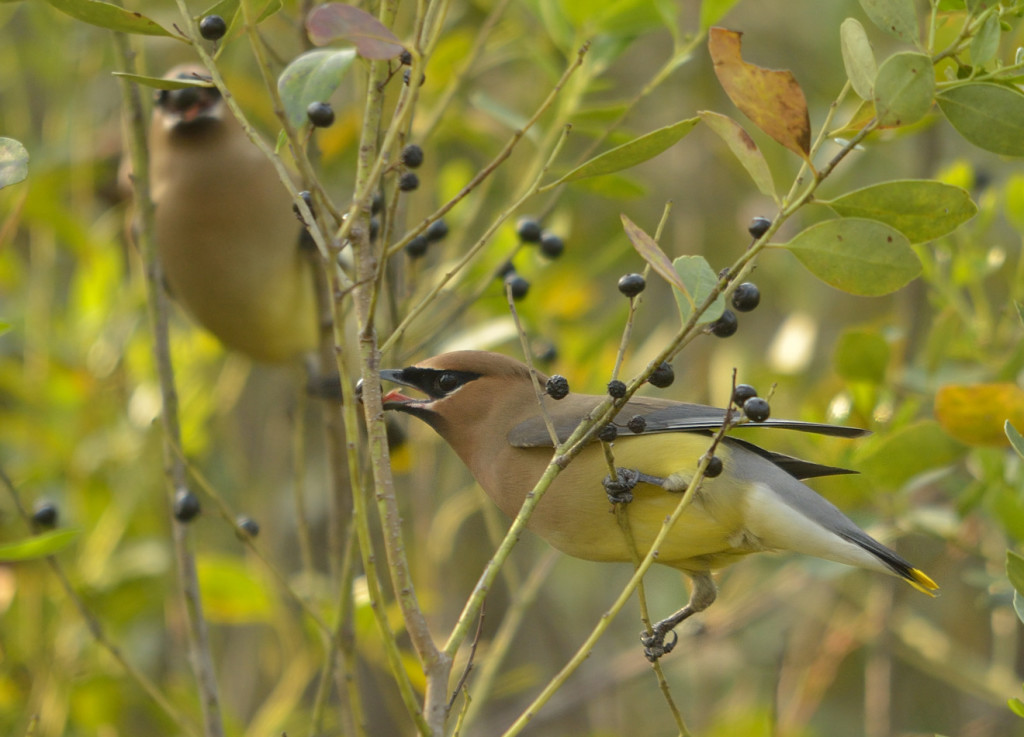
Cedar waxwings in the pine flatwoods of Heart Island, feeding on the fruits of Ilex glabra, or inkberry.
Cedar waxwings, and the other two species of waxwing (Bohemian and Japanese) which collectively make up the entire family Bombycillidae, are true frugivores, depending almost entirely on fruit for most of the year. They do switch to a partial reliance on other foods in the spring and summer; in May, they rely heavily on flower buds, of all things, and later in the summer when they begin feeding nestlings they take a greater proportion of insects, necessary to provide the proteins lacking in most fruits.
The quest for fruits has led cedar waxwings to evolve a peripatetic lifestyle for all but those few months of the year when they must drop anchor to nest. Consequently, for bird photographers, and birders in general, they are a challenge to find at will, and a delight to see and photograph when found. As winter visitors to Florida, they are guaranteed to show up at some time or another between about October and May, but exactly when and where that will be is subject to a great deal of whimsy. For a bird photographer to state with any sense of confidence that I’m going to photograph waxwings today is a proclamation as foolish as planning to win a Powerball drawing. Unless he or she happens to be looking at them at that very moment. Here today, gone an hour later.
Ornithologists concerned with classifying patterns of bird movement express hesitation at calling waxwings migrant, though they do show regular patterns of southward and northward movement at a broad scale, at the appropriate times of year. Those movements, though, do not begin to approach the level of regularity and predictability of most true migrants. They show relatively low levels of philopatry in the breeding season; in other words, unlike many birds, they don’t tend to return to the same breeding areas year after year, and during the winter their movements seem to be completely irregular and unpredictable. Both of these characteristics are related to their reliance on fruit, which is itself somewhat unpredictable in time and space, and once found, subject to rapid depletion once big flocks of frugivorous birds discover it.
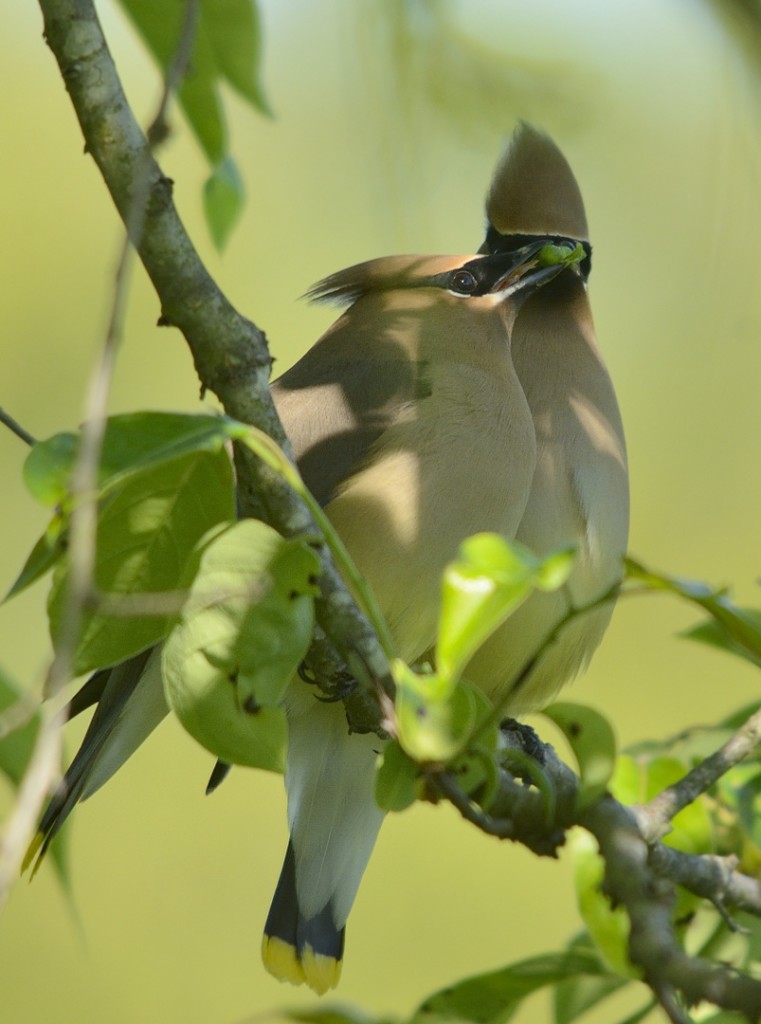
A cedar waxwing pair passing a piece of fruit back and forth, part of their courtship and pair-bonding ritual.
The ability of big flocks to rapidly consume most or all of the fruit in an area is one of the most appealing aspects of their behavior. Watching a writhing, swirling mass of lovely pastel-colored birds attack a mass-fruiting holly or cherry tree and pick it clean within a few minutes is an amazing sight. Part of the appeal of that behavior is the furious and fanatical way they conduct their feeding frenzies; birds are constantly moving into and out of the fruiting tree, plucking a few fruits and quickly departing to perch nearby before the next foray. The result is often a maelstrom of activity that can be over and done with in the blink of an eye. Followed by the departure of the flock to parts unknown, seeking their next meal.
Waxwings have been less abundant this season than my notoriously untrustworthy memory suggests they usually are. Some winters between January and February, they descend on DeLand in huge numbers, with flocks numbering in the thousands. For the few days or weeks they are around, it’s hard to miss the big roving groups bopping around town devouring every fruit in sight. One morning they might be devouring the fruits of sabal palms in the parking lot of the Publix where I shop, the next at a yaupon hedgerow near a strip mall. A few years ago, huge flocks were on the Stetson campus for several days in a row; one morning on my way to my office, a flock of hundreds was feeding and drinking around the Gillespie museum, and I spent a delirious hour or so photographing them. Students in my Intro Biology II class were subjected to 15 minutes of my rantings about and photographs of the waxwings that morning, exhorting them to be on the lookout for these wonderful wanderers over the next few days. I have no idea whether that rant led anyone in that class to give even a second thought about waxwings afterwards; probably to them the most salient fact about my waxwing rhapsody was that it wouldn’t be covered on the next test. Another morning, as I was driving through the new development next to the one I had just moved into, I photographed a small flock of waxwings beefing with a group of robins over a few drops of water beaded atop an electrical junction box. To photograph waxwings requires eternal vigilance.

Waxwings and robins competing for space and a few droplets of water atop an electrical junction box.
Last Sunday afternoon I was drifting in and out of a mid-afternoon stupor when I was awakened by the wick calls of a couple of robins in the backyard. Robins shifted into their urban phase several weeks ago, and have been fairly common in the neighborhood and around DeLand. The presence of flocks of robins indicates the possibility of waxwings in the area – the two often travel together, and feed together at mass-fruiting plants. I had only seen waxwings in my neighborhood a couple of times so far, though, and none had been feeding. I have several large wild cherry trees with large fruit crops I had been keeping my eye on, and though I had seen robins feeding at them several times, they were never accompanied by waxwings. Soon after I heard the robin calls, one of them flew down to the birdbath, soon to be joined by another. And then I heard the high, quavering seeee calls of a couple of waxwings, and I was instantly wide awake. I happened to have my camera with big bird lens on the couch beside me, and was ecstatic when a pair of waxwings joined the robins at the birdbath. I fired off a couple of record shots, and then the birds spooked and took off. Soon they were back, accompanied by a half-dozen or more additional waxwings, and they and the robins spent the next three or four minutes bathing and occasionally sparring for position. I eased out the back door onto the enclosed patio, and was shooting nearly non-stop the entire time they were there. Hoping like hell that all the settings were right, because I had no time to stop and chimp my shots to ensure I wasn’t making some major bonehead mistake.
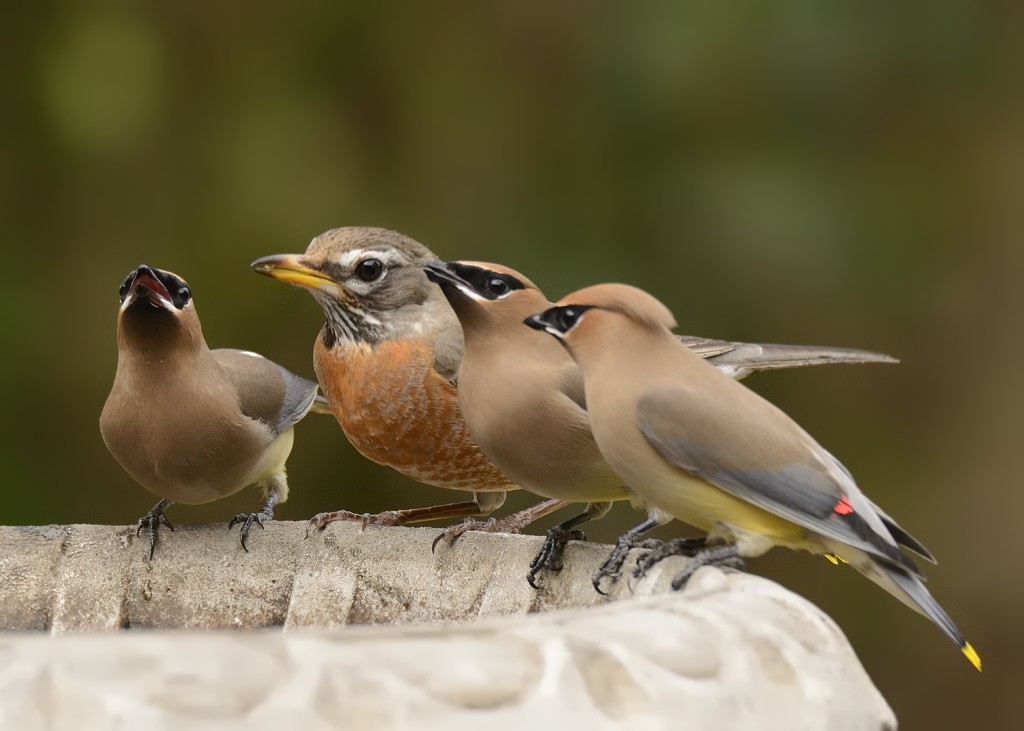
Though they have their occasional spats, peaceful coexistence between the robins and waxwings is possible.
Soon, though, something signaled the waxwings it was time to move on, and they departed en masse, trilling as they winged away. I haven’t seen them in the neighborhood since, and may not again this winter. And that’s okay. They graced me with their presence and gave me reasonable photo opportunities for a few minutes, and for that I’m thankful. See you next year, my friends. I hope.
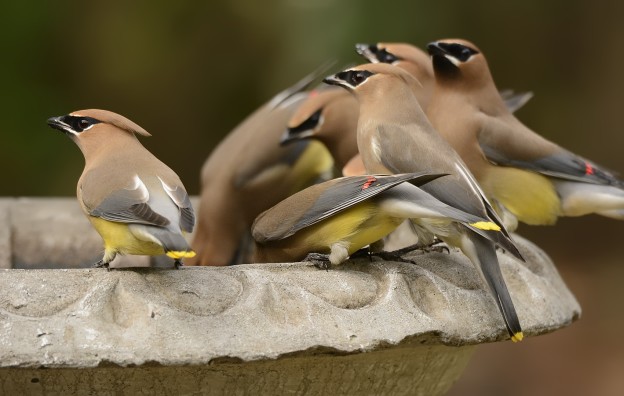
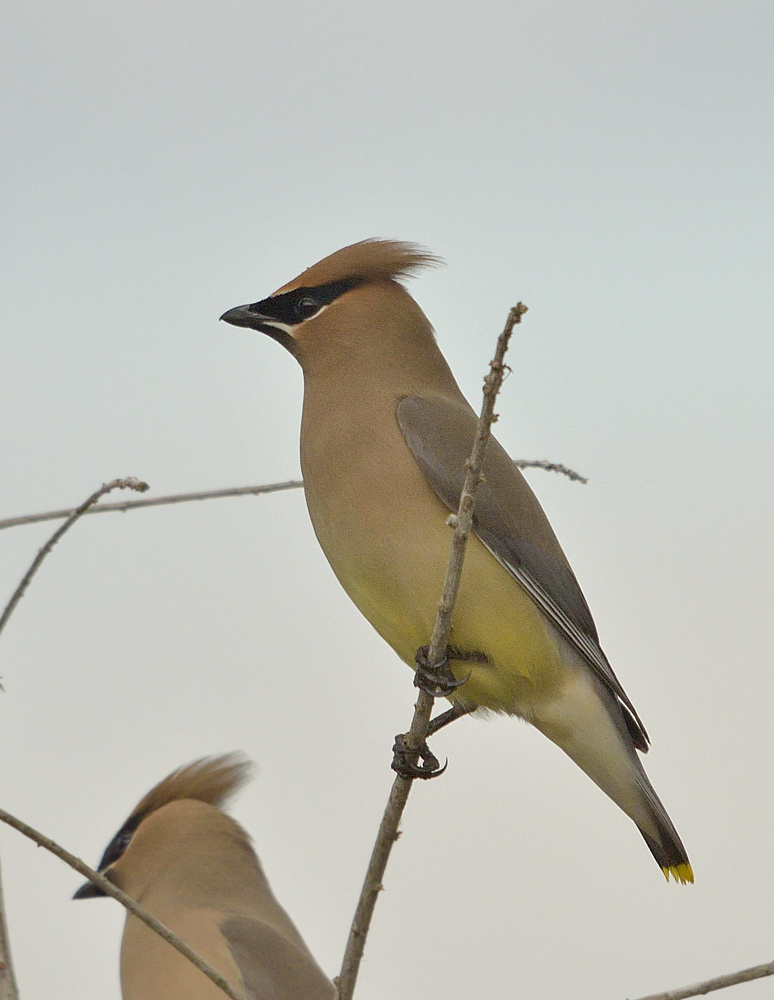
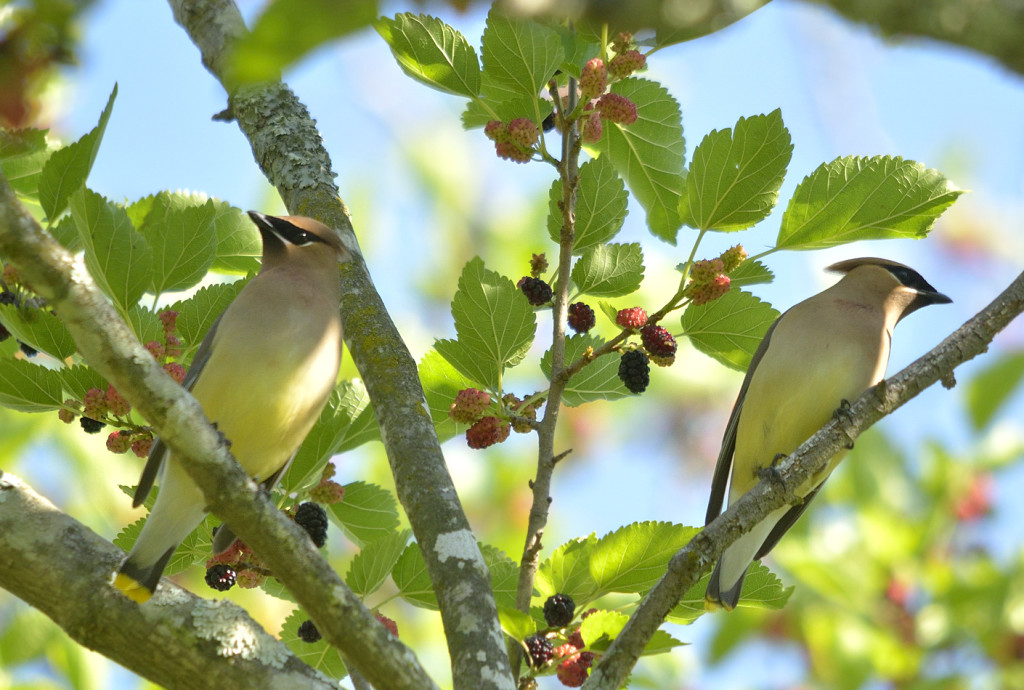
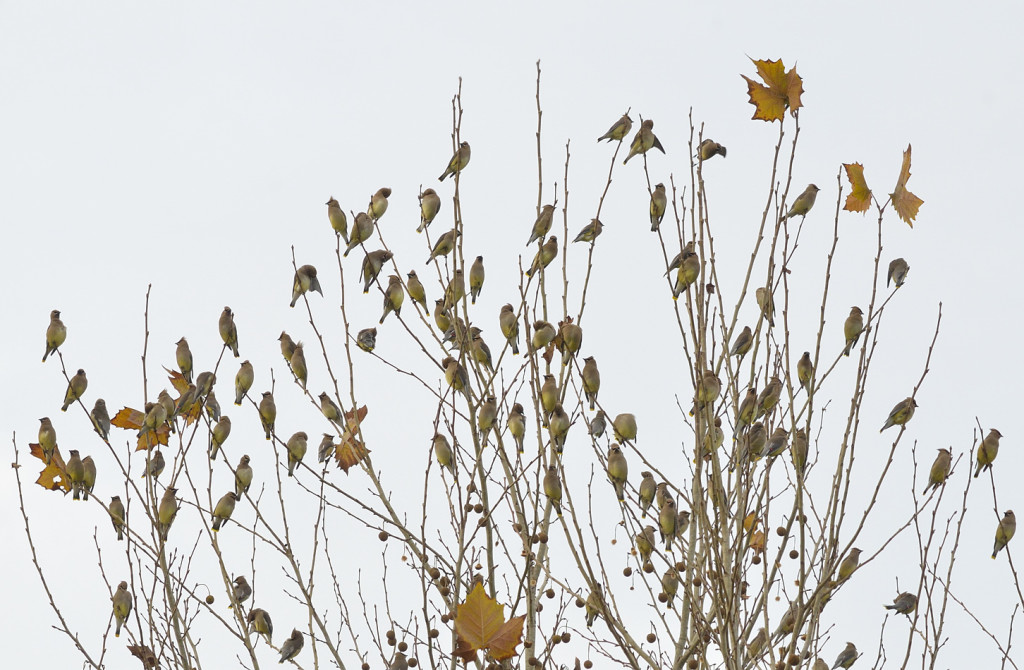
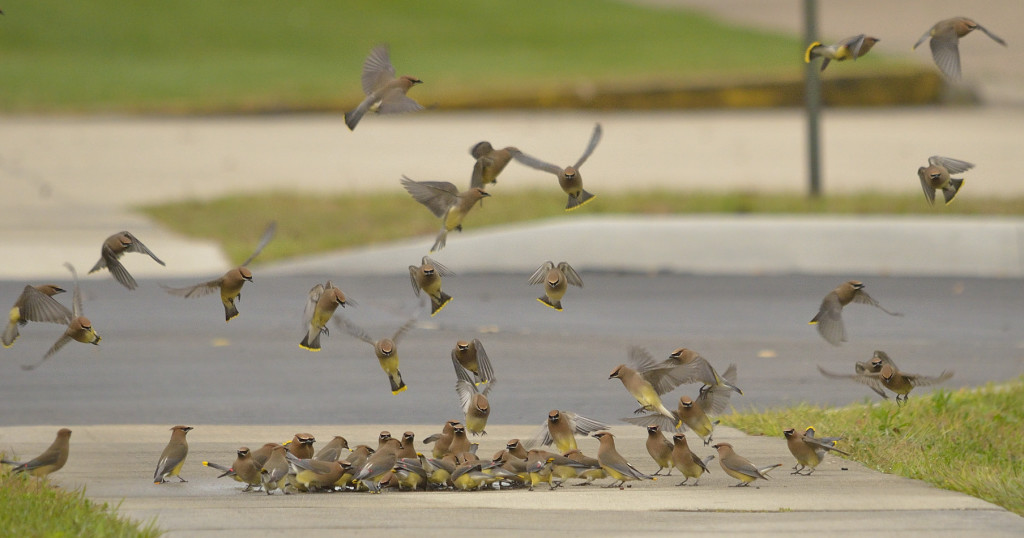
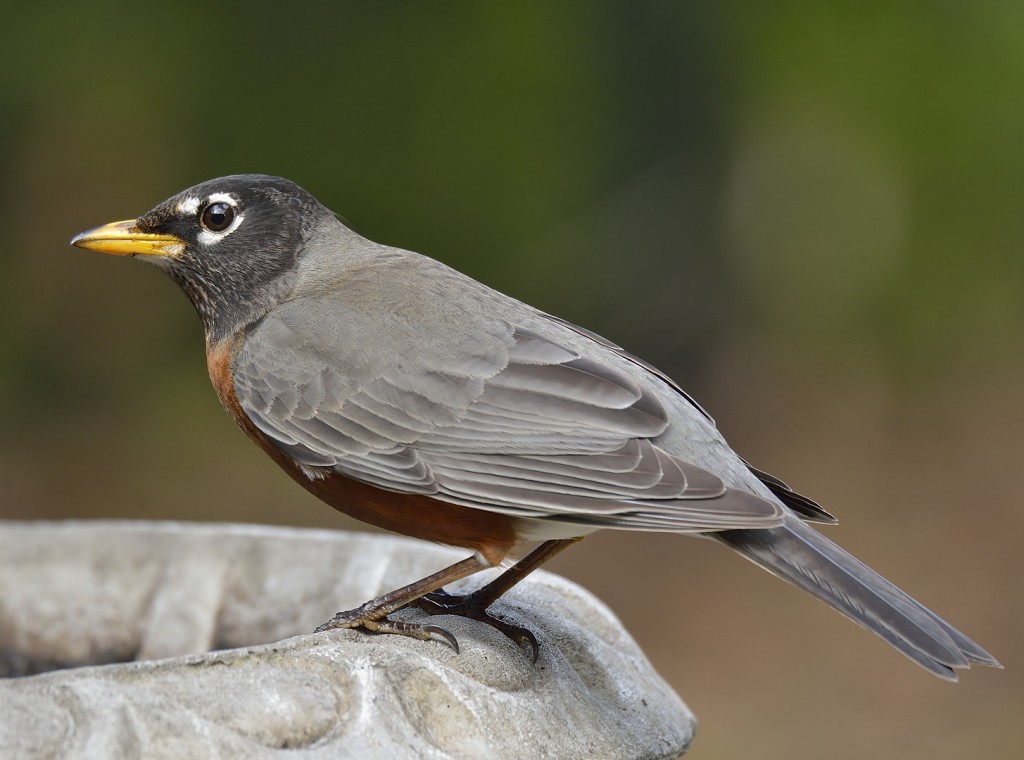
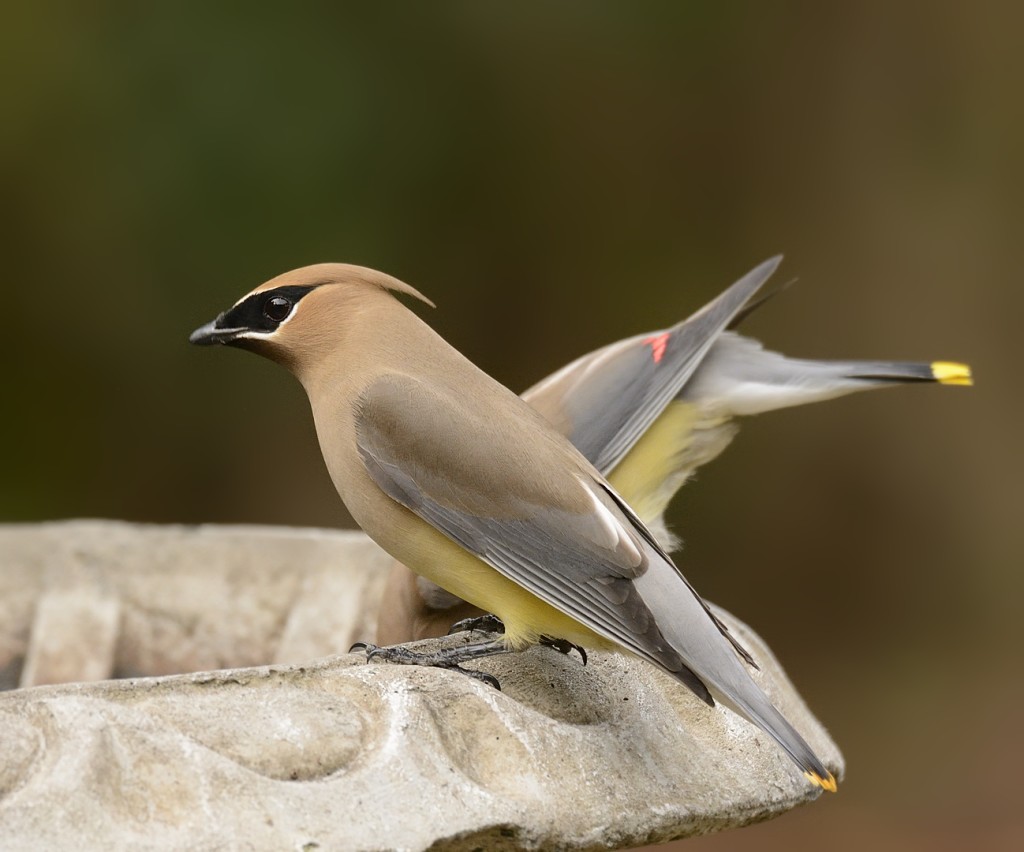
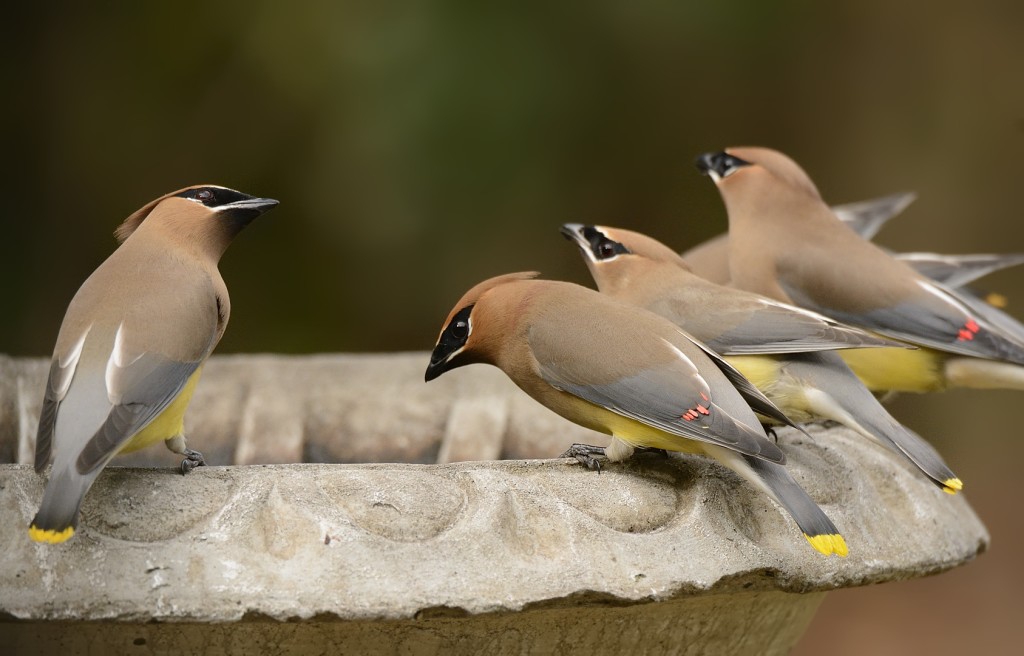
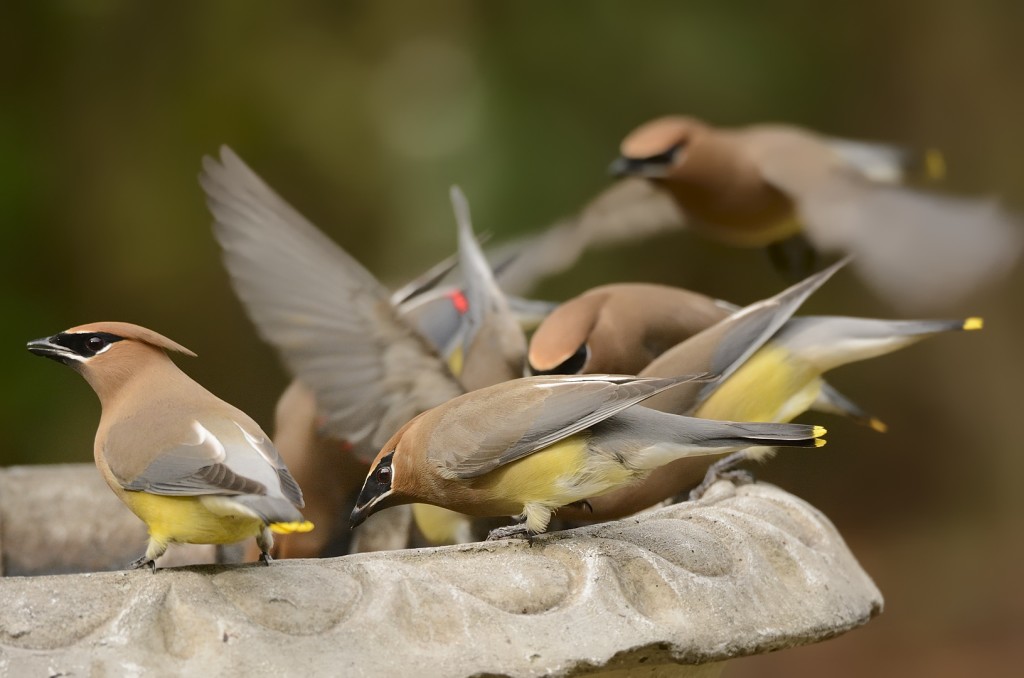
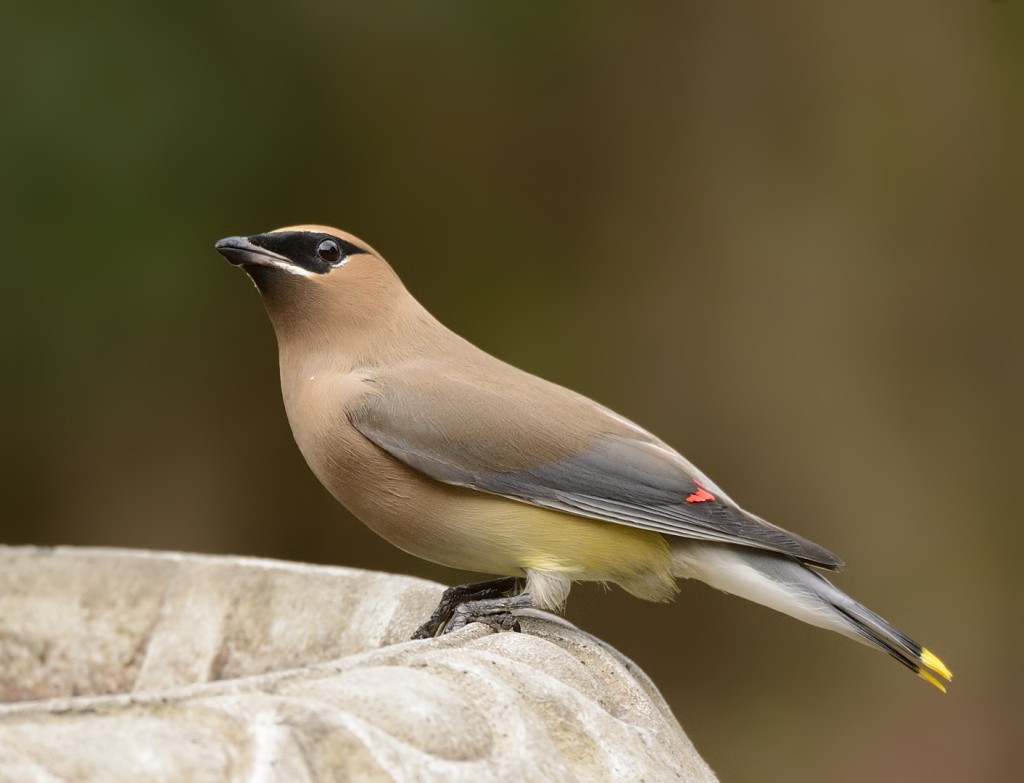
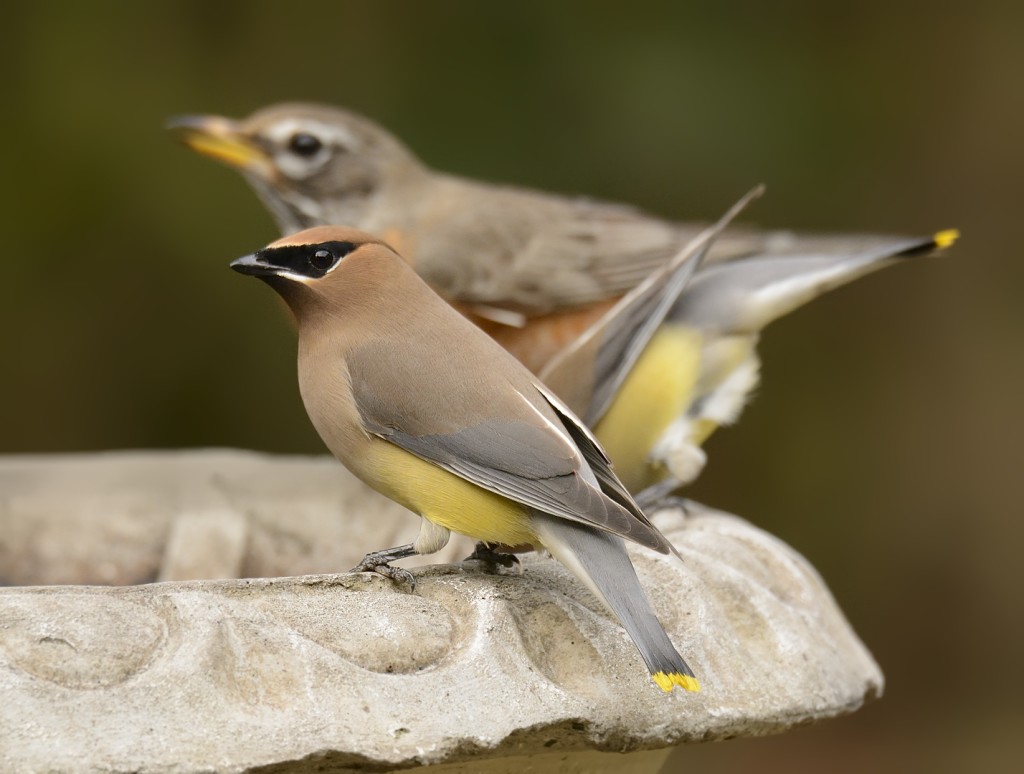
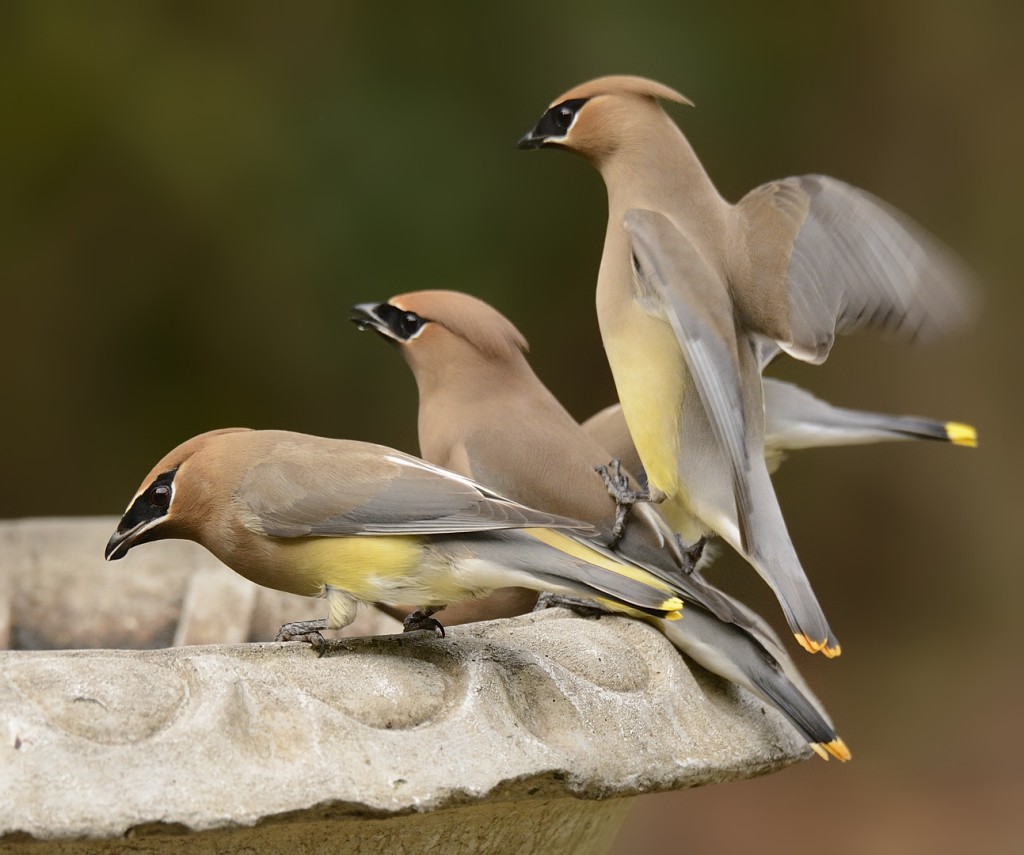
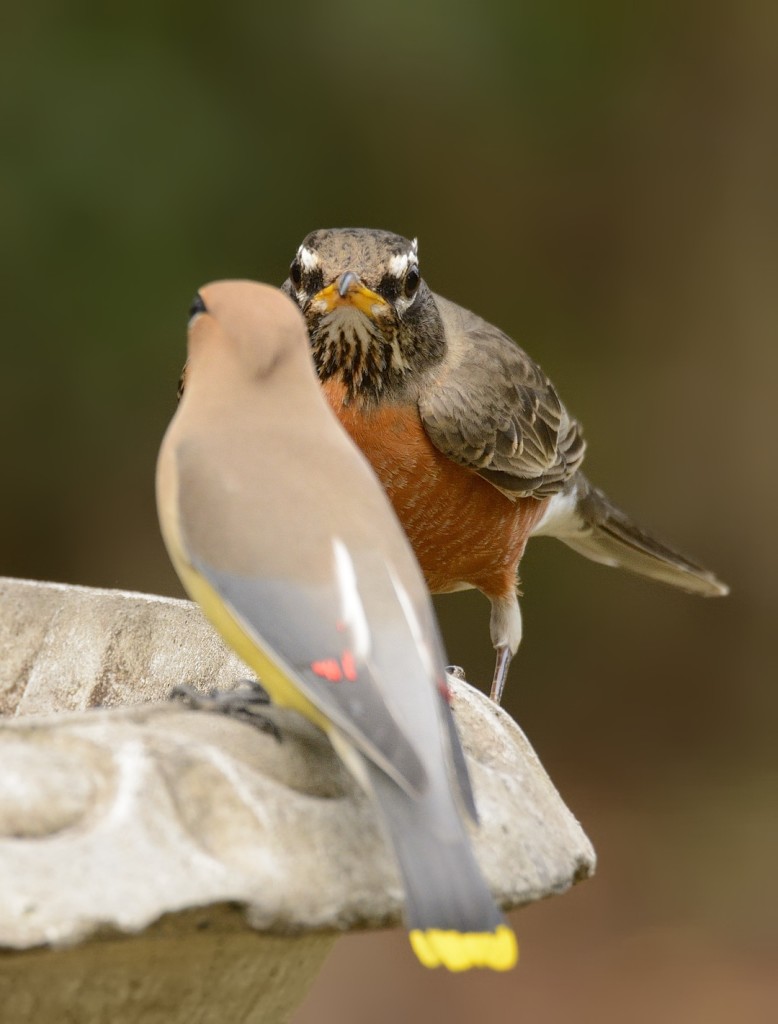
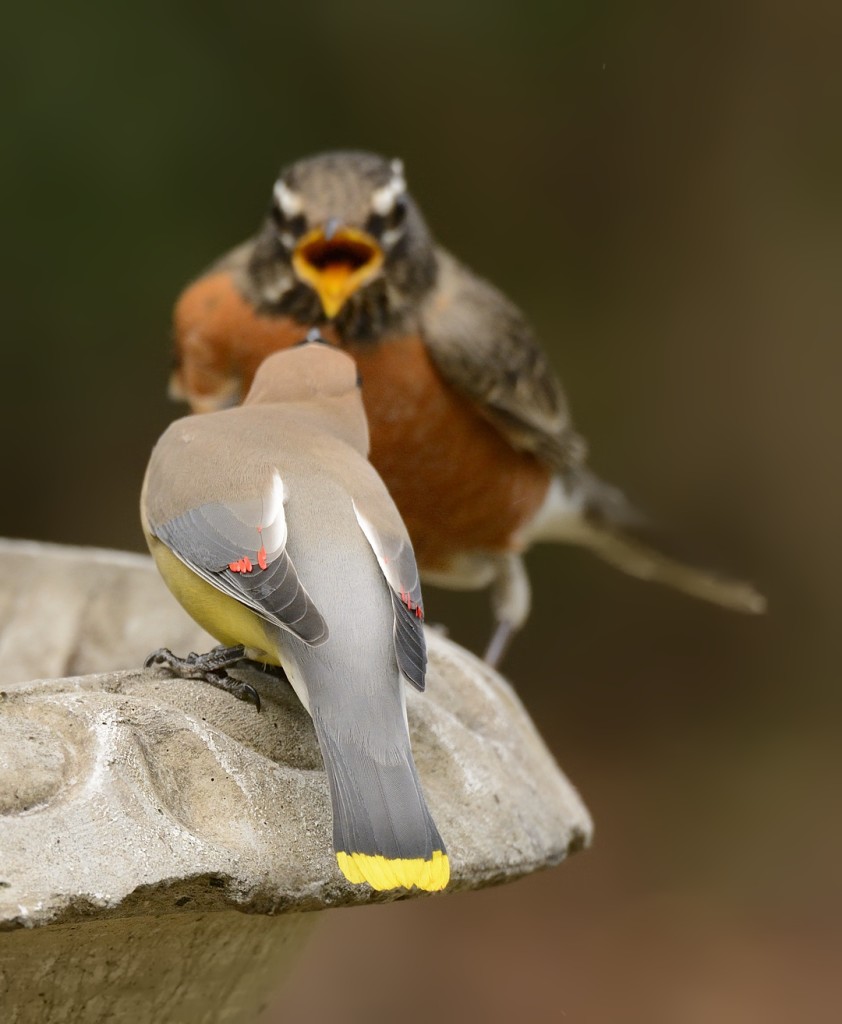
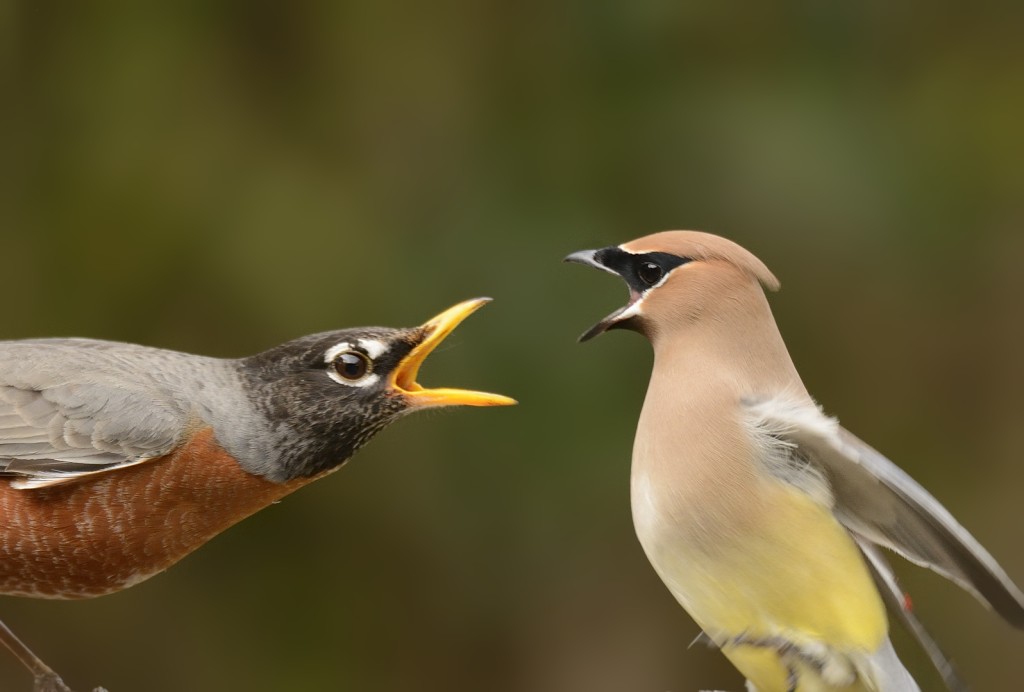
very much enjoyed! good information and especially liked the pictures of the robins and waxwings squawking at each other in the birdbath. i feel the same way you do about the push and pull of the nomadic lifestyle. interesting segway into the theme of your post.
The thing I’ve always liked about Waxwings is their elegant, unruffled look. The feathers seem to create a glossy, perfect surface (compare, for example, to the robins in your shots). What is it about their feathers that gives them this look?
Good to see another VN posting.
Thanks, Gene. I’ve searched quite a bit for the answer to this very question, and I can’t find any information about it, though the distinctive look of waxwings is frequently commented on. Even the definitive Cornell site, Birds of North America Online, provides no answer. There are a few other birds I can think of that have a similar plush look, such as the Old World touracos. It has to have something to do with the ultrastructure of the feather components, and in particular the barbs and barbules, but I don’t know exactly what it is. The obvious follow-up question is why? What is the adaptive function of this particular look or feather structure?
I enjoyed this post more than a little bit as this is the first year I’ve been able to obtain fairly decent photos of waxwings. It’s great each year to hear their high-pitched calls and then start searching for the flock. Your images of large numbers of birds and the interaction with the Robin are especially interesting.
Thanks, Wally. I’ve been enjoying your blog posts as well.